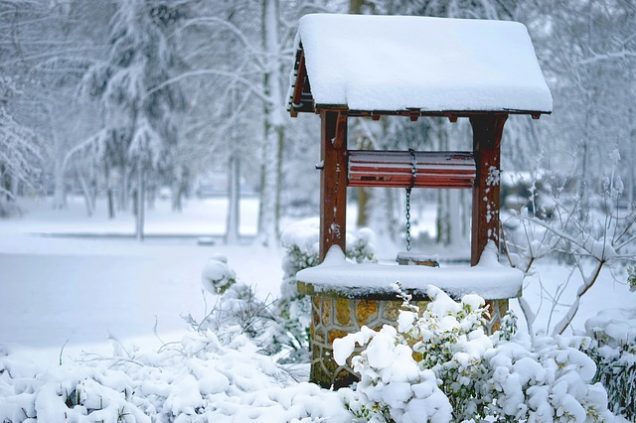Winter in Connecticut can bring freezing temperatures that put your well water system at risk. While your actual well is safely below the frost line (about 42 inches in Connecticut), certain components above or near the surface are vulnerable. Frozen pipes, a frozen jet pump, or other exposed parts of your well water system can lead to costly damage, loss of water pressure, and emergency repairs.
At Greco & Haines, homeowners often ask us how to prevent their well system from freezing and what to do if pipes or pumps freeze during a cold snap. In this guide, our well water system mechanics share practical tips for winterizing your well, protecting your pump and pipes, and keeping your water flowing all winter long.
Can a Well Freeze in Connecticut?
The well itself does not freeze because it sits below the Connecticut frost line, which averages about 42 inches deep. At this depth, the surrounding earth naturally insulates the water source, keeping it well above freezing even during the coldest winters.
The real risk comes from the components above or near the ground, such as the wellhead, exposed pipes, or jet pumps. These parts can freeze quickly in subzero weather, especially if they are not insulated or are located in unheated areas like crawlspaces or basements. Protecting these vulnerable sections is the key to preventing well system freeze-ups in Connecticut.
Can a Well Pump Freeze?
A submersible well pump located deep inside your well is not likely to freeze. These pumps sit well below Connecticut’s frost depth and remain insulated by the surrounding earth and groundwater.
By contrast, a jet pump, which is often installed in a basement, crawlspace, or aboveground housing, is far more vulnerable to freezing. When exposed to subfreezing air, the water inside a jet pump or its nearby pipes can freeze solid. This can cause the pump to stop working, reduce water pressure throughout your home, and even crack pipes or pump housing, leading to costly repairs.
Other at-risk components include:
- Supply pipes running from the well to the home if they pass through unheated areas.
- Household plumbing located in uninsulated basements, crawlspaces, or utility rooms.
- Fixtures and pipes exposed during a power outage when heat is lost inside the home.
Even temperatures just above 32°F can cause problems when combined with strong winds. Windchill can create freeze conditions in poorly insulated or exposed pipes faster than homeowners expect.
Protecting Your Well Pump and Pipes From Freezing Temperatures
Most Connecticut wells are installed below the frost line, so the water source itself is safe. The real focus is protecting the aboveground or shallow components of your system. Here’s a step-by-step checklist to keep your well water system safe during cold snaps:
Winterization Checklist for Connecticut Well Systems
Insulate Aboveground Components – Cover exposed water lines with foam pipe insulation. Place your wellhead and jet pump inside insulated housing.
Seal and Cover Vulnerable Pipes – Wrap pipes in unheated areas (crawlspaces, utility rooms, garages). In a pinch, use materials like bubble wrap, blankets, or even old clothing for temporary protection.
Apply Heat Tape Where Needed – Install UL-listed heat tape on pipes at risk of freezing.
Leave about an inch of spacing between wraps to avoid overheating.
Use a Safe Heat Source – A heat lamp or low-watt incandescent bulb can provide extra warmth in well houses or pump enclosures. Always follow safety guidelines to avoid fire hazards.
Check During Cold Fronts – Inspect insulation regularly, especially after snow, ice, or strong winds. If temperatures drop below freezing with high winds, pipes may freeze even if the air temperature is above 32°F.
Running Your Taps to Prevent Frozen Pipes
Keep Water Moving
During a cold snap, let a faucet run at a slow trickle or rapid drip. Moving water is less likely to freeze inside pipes.
Protect at-Risk Areas
Choose a faucet that’s connected to pipes in unheated spaces (like basements or exterior walls). This helps protect the most vulnerable parts of your system.
Don’t Worry About Waste
The small amount of extra water used is minimal compared to the cost of repairing a burst pipe or replacing a frozen jet pump.
What to Do If Your Well Pipes Freeze
Check for Symptoms
Signs of a frozen pipe include low water pressure or no water flow at all.
Open Your Faucets
Turn on affected taps to relieve pressure in the system. This reduces the chance of pipes bursting as ice expands.
Apply Safe Heat
Use heat tape, a space heater, or a hair dryer to slowly warm the frozen section. Do not use open flames. Once water starts flowing, remove the heat source.
Call for Professional Help
If you cannot locate or thaw the frozen section, contact Greco & Haines. Even if you restore water on your own, it’s smart to schedule an inspection with our well water system mechanics to check for hidden leaks or damage.
Winterize Your Connecticut Well System With Greco & Haines
The best time to protect your well system from freezing is before winter arrives. An annual well water system inspection helps identify issues early, and simple maintenance steps are easier to handle before the ground freezes or snow sets in.
Call us today to schedule a well water system inspection or emergency service anywhere in Connecticut. If you have questions about your well system or need expert assistance, Greco & Haines is here to help. With a longstanding reputation for quality service across Connecticut, we’re dedicated to keeping your water supply clean, safe, and reliable. Give us a call anytime at 203-735-9308, 203-777-2256, or toll-free from any CT area code at 1-800-922-2958.

